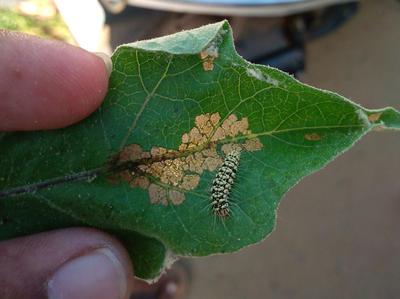Eggplant Leaf Roller
Eublemma olivacea
Insect
In a Nutshell
- Larvae feed on tender, new leaves giving a ragged appearance.
- Young leaves are rolled lengthwise.
- Rolled leaves are brown and eventually dry.
- In heavy infestations entire portions of plants appear brown and leaf drop occurs.
Can also be found in
Symptoms
Only the larvae cause damage to the leaves. Initial symptoms appear as lengthwise rolled leaves where the larvae are located. From there, they chew on the internal green tissue of the leaves. The damage appears on the top parts of the plant most. Rolled leaves can become brown, wilt and dry. When the damage is heavier, the browning spreads to entire plant parts and is followed by defoliation. This can lead to significant yield loss if the population of insects is not controlled. However, the pest is rarely a major threat to plant development and yield.
Recommendations

Organic Control
Biological control by parasitic wasp species such as Cotesia spp. can be used to reduce the infestation. Also predatory insects such as mantis or beneficial ladybird beetle species may help to control the pest. Nematodes such as Steinernema spp. may help controlling the pest, too.

Chemical Control
Always consider an integrated approach with preventive measures together with biological treatments, if available. If insecticides are needed, spray recommended products to reduce populations of the eggplant leaf roller.
What caused it?
The adults are medium sized, light brown to olive green moths with a large three-sided darker patch on the outer area of the forewing. Hindwings are translucent white. The female moths lay eggs in groups of about 8-22 on the upper side of the leaves, more commonly on the younger ones. After about 3-5 days the larvae hatch. They are purple-brown and stout with yellow or cream hollow bumps and long hairs on the back. The larval growth period is about 4 weeks. Then they pupate inside the rolled leaf. After an additional period of about 7-10 days the new generation of adult moths hatch. There may be 3-4 generations per year, depending on climate conditions.
Preventive Measures
- Planting later in the season is recommended.
- Grow healthy plants with a good fertilization program.
- Check your plants or fields for any sign of disease or pest.
- Handpick infested leaves and caterpillars.
- Remove or destroy infested leaves, caterpillars and your waste by burning it.
- Avoid indiscriminate insecticide use that destroys natural enemies of the pest.



